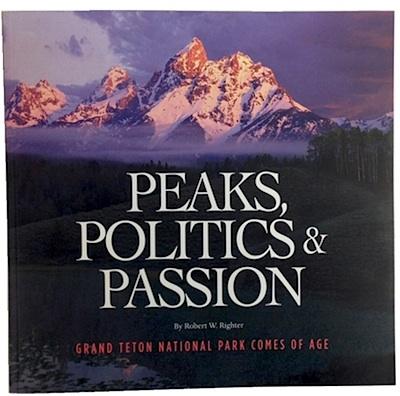
Creating national parks is not a clean, simple process, and that certainly was not the case with Grand Teton National Park, where a little subterfuge was needed to preserve the landscapes millions of visitors enjoy each year.
More than a few landowners and politicians opposed the expansion of the Jackson Hole National Monument that President Franklin Delano Roosevelt established in 1943 into the wonderfully panoramic national park that exists today. How the expansion was accomplished is outlined by Robert W. Righter in his latest book, Peaks, Politics & Passion, Grand Teton National Park Comes of Age ($24.95 from the Grand Teton Association).
This 294-page book focuses on the act in 1950 that established Grand Teton up through the at-times rancorous fits and struggles to acquire private inholdings, the failures to create officially designated wilderness areas within the park, to the ongoing debate over the purpose of parks. Should they exist to entertain visitors, or to protect and preserve nature?
While it's satisfying to know that the National Park System protects places such as the Teton landscape, understanding the undertows that can arise and threaten the establishment of parks is just as vital, both for the historical significance as well as for future efforts to create parks. Dr. Righter, a Research Professor of History at Southern Methodist University, brings this background to the forefront in Peaks, Politics & Passion in a fashion both informative and entertaining.
He delves into the tradeoffs the National Park Service ultimately made to see Grand Teton created -- grazing was allowed to continue, hunting of elk is permitted to this day (though it's referred to as 'culling'), the federal government agreed to compensate Teton County for lost property taxes for a period of 24 years -- details how some inholders were bought out (the prickly negotiations between the Craighead brothers, John and Frank, groundbreaking wildlife biologists, are particularly interesting), and he brings the political might of ranchers to the surface in this book.
The subterfuge, of course, involved the Snake River Land Company created by John D. Rockefeller, Jr., to purchase private lands that he would later gift to the government for a larger national park. That it took a threat from Rockefeller to sell the lands to private interests to help convince the federal government to accept the gift is all part of the story.
Along with preserving lands through his purchases, Rockefeller also preserved a sense of place in the Tetons by seeing that the park didn't "go down" the commercial path that was blazed through Yosemite National Park; among other things, he bought out a dance hall near Jenny Lake and stopped a ranch south of Timbered Island from moving beyond a rodeo to more elaborate means of entertainment.
Laid down between the covers of this insightful book by Dr. Righter are Park Service foibles in developing a sound management approach for Grand Teton and how the agency turned its back on wilderness designation.
In perhaps only the latest chapter in Grand Teton's storied history, the historian also questions, along with many others of today, what role national parks should serve, and how their worth should be measured.
We live in a capitalist society that worships growth. Whether it is a business, the stock market, a city, or a nation, a healthy enterprise must demonstrate expansion. Is this a legitimate measure for a national park? We should be careful how we apply it. A better measure of success should be the preservation and enhancement of the resource and the quality of services provided. The simple idea of "bigger" flies in the face of the Organic Act of 1916, breaking the convenant and the mandate to maintain resources unimpaired for future generations. Nowhere in the Management Policies, 2006 manual is there an imperative for parks to grow.



Add comment